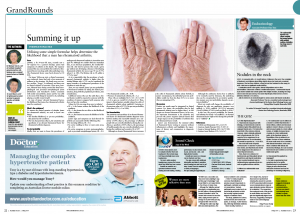 This article was published in Australian Doctor in the “Grand Rounds” segment.
This article was published in Australian Doctor in the “Grand Rounds” segment.
Authors: Michael Tam and Joel Rhee
This article is also available on the Australian Doctor website (registration required).
CASE
James, a fit 70-year-old man, recently saw our GP registrar for a general check up. Assuming James had osteoarthritis of the hands, she ordered a rheumatoid factor (RF) along with other pathology tests. When the RF came back elevated, at 50 IU/L, we were both taken aback — the registrar had expected the result to be normal, and I wasn’t sure how to interpret the finding.
On James’ follow up visit, I took the opportunity to conduct a clinical assessment. James had but a few moments of stiffness in the morning. His hands were not tender, swollen, “boggy”, or inflamed: there was no clinical evidence of synovitis. There were, however, bilateral bony lumps around his DIP and PIP joints, Heberden’s and Bouchard’s nodes, respectively, and consistent with nodal osteoarthritis. James was able to do most of the things he wanted to do, including playing a weekly round of golf.
QUESTION
In view of the elevated RF, what is the likelihood that James has rheumatoid arthritis (RA)?
WHAT’s THE EVIDENCE?
To answer this clinical question, we need to know two things:
- the baseline likelihood, or “pre-test probability” that James has RA, and
- the test characteristics (that is, the sensitivity and sensitivity) of an elevated RF for RA diagnosis.
Pre-test probability
Ideally, firstly we would want to know the prevalence of undiagnosed RA in Australian men aged 70 years. Although we couldn’t find any Australian data, in an American population, the residual lifetime risk — the risk for persons who reach a given age without yet developing a disease — of developing RA for men at age 70 was 0.73% (about 1 in 140); the lifetime risk in US adults is 1.7% for men. 1
It is improbable that the prevalence of undiagnosed RA is higher than the residual lifetime risk, so 0.73% can be considered the upper boundary of undiagnosed RA prevalence in men this age.
Then, we can estimate James’ pre-test probability of RA by taking his clinical presentation, along with the population prevalence, into consideration.
Likelihood ratios (LRs) are the odds that a clinical feature (for example, a symptom or a sign, or a test result) would be expected in someone with the condition of interest compared with someone who does not have the condition.
Values for LRs can range from zero to infinity:
- LR < 1 – the feature reduces the likelihood of the condition
- LR = 1 – the feature has no effect on the likelihood of the condition
- LR > 1 – the features increases the likelihood of the condition.
James’ signs and symptoms (or lack thereof) for RA are associated with the following LRs: 2
- no morning stiffness, LR = 0.5;
- no active swelling in three or more joint areas, LR = 0.5;
- no active symptoms in wrist, MCP or PIP joints, LR = 0.4;
- no rheumatoid nodules, LR = 0.98; and
- presence of symmetrical arthritis, LR = 1.2.
These LRs are multiplied (0.5 × 0.5 × 0.4 × 0.98 × 1.2) to give an overall LR of about 0.12. Thus, James’s clinical picture actually reduces his odds of RA around 8-fold. Factoring in the previous value of 0.73%, his pre-test probability of RA is less than 0.1% (< 1 in 1000).
Test characteristics
The sensitivity and specificity of an elevated RF for RA diagnosis varies between studies, but reasonable estimates area sensitivity of 69% (that is, the percentage of affected people who are correctly identified as having the condition), a specificity of 85% (that is, the percentage of healthy people who are correctly identified as not having the condition). This gives a positive LR (i.e., the LR for a “positive” test which is an elevated RF in this case) of 4.9. 3
Although an elevated RF does increases the odds of RA about 5-fold, in James’ circumstance, his individual post-test probability of RA would rise from less than 0.1% to no more than an uninspiring 0.5%.
DISCUSSION
“Positive” test results must be interpreted in clinical context. For James, the probability that he had RA was no higher than 1 in 200 despite an elevated RF. In his case, the important determinant is his relatively tiny pre-test risk: James’ negative clinical features had a larger impact on the probability of RA than the RF result.
James’ case demonstrates the minimal utility of RF testing in someone without inflammatory arthritis, highlighting the importance of history and examination in diagnostic assessment.
Although the arithmetic we’ve shown here is unlikely to be routinely used by clinicians, the underlying idea can be conceptualised in an intuitive qualitative manner: post-test probability depends on pre-test probability. 4
Most test results will change the probability of diagnosis by only one qualitative category — very unlikely (< 10%) ↔ unlikely (10-33%) ↔ uncertain (34-66%) ↔ likely (67-90%) ↔ very likely (<90%). 4
In this case, the pre-test probability for RA was clearly “very unlikely”. An elevated RF might at best change this probability to “unlikely”.
References
- Crowson CS, et al. The lifetime risk of adult-onset rheumatoid arthritis and other inflammatory autoimmune rheumatic diseases. Arthritis and rheumatism 2011; 63:633-39.
- Rindfleisch JA, Muller D. Diagnosis and management of rheumatoid arthritis. American family physician 2005; 72:1037-47.
- Nishimura K, et al. Meta-analysis: diagnostic accuracy of anti-cyclic citrullinated peptide antibody and rheumatoid factor for rheumatoid arthritis. Annals of internal medicine 2007; 146:797-808.
- Medow MA, Lucey CR. A qualitative approach to Bayes’ theorem. Evidence- based medicine 2011; 16:163-67.
